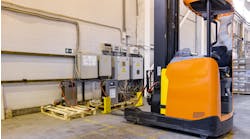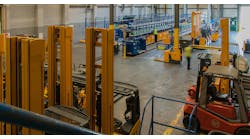By Roger Morton
Taking serious stock of present locations and distribution infrastructure can lead to conclusions that drive companies to seek thirdparty help. “We have been in existence since 1898 and in the same facility since 1987,” explains Joanne Berwald, vice president of operations, for Buxton. “We were finding with the retail environment changing as rapidly as it was, combined with changes in our product line, that we were limited in what we could do here in our facility.”
Located in Springfield, Mass., Buxton produces quality leather goods under its own name as well as Dopp, Wenger and some private labels for major retailers. Since 1986, the company has manufactured offshore, in Asia, with most of its product moving to the U.S. by ocean freight.
Buxton was having an increasingly difficult time supporting its retail business from its East Coast facility. “Number one, we couldn’t expand our footprint at all,” Berwald notes. “Number two, when we started to look at what type of capital improvement would be needed—not only from an equipment standpoint but from a systems standpoint, as well—we didn’t want to spend that kind of money when there are people out there that already have the infrastructure in place.”
The company’s eastern location was causing some problems. Buxton was finding lead times growing longer, causing late deliveries and increases in the need to use air freight. “Those two factors were a double whammy for us,” says Berwald.
The answer for Buxton was to outsource nationwide distribution to Weber Distribution, based in Santa Fe Springs, Calif. Lance Jordan, Weber’s director of corporate operations, notes that Buxton was operating in a 100,000 square foot facility in Massachusetts. “We were able to consolidate that into 60,000 square feet with better storage methods.”
With a diversity of final customers with varying shipment compliance requirements, Jordan explains that Weber was already dealing with 80% of Buxton’s clients. “We have an internal retail compliance manager and program in place,” says Jordan, “so we could quickly get them up to speed.”
John Nutt, Weber COO, stresses the point. “Customers coming to us want to make sure we already have established trading relationships with their customers. With retail compliance issues, the label has to be proper. You have to have EDI experience with that retailer and the right bill of lading and so forth. Because we understand the retail compliance requirements, that gives our customers a high level of comfort that we’re going to take care of their customers.”
Buxton products are stored and orders routed and picked by the case or pallet for big-box retailers like Staples and Office Max at Weber’s facility in La Mirada, Calif. It’s from this location that consolidated containers are transloaded to the Weber Rancho Cucamonga, Calif., facility. It’s here that Buxton value-added services are handled and orders picked, packed and then routed. Weber explains that Buxton maintains 4,600 unique SKUs and ships 1,250 orders each week containing 2,500 cases or 87,500 units.
“Weber handles 100% of our distribution to our retailers as well as fulfillment for e-commerce that we do through a few Web sites,” notes Berwald. “We’re dealing with all of the regular national chains, like Sears and JC Penney, and we do private label for Target. Weber warehouses all of our product. They pick and pack. They prepare and stage it for shipping. They route all the orders through the retailer’s Web sites. They, in turn, are passing all of their information via EDI to us, and we do a pass-through to the customer. So, to our retail customers, it’s seamless.”
The Weber Web portal is accessible to all customers with real-time data for inventory and orders. It offers dedicated reporting that can be downloaded into Excel or PDF. The site includes inventory orders, inventory activity and other data. Jordan claims East Coast customers particularly appreciate that access, because when they arrive at their offices three hours ahead of Weber, they are up to speed on that day’s or the previous day’s activities.
“Any report we might need,” says Berwald, “whether it’s an aging history or pending outbound or something to be picked or is in the picking process, all of that is in real time online. So, we are able to communicate to our customers just as if they were on the other side of the wall and not 3,000 miles away.”
Weber provides outbound transportation where the shipment is not already freight-collect. Most of Buxton’s freight is collect. The movement is paid for by the final consignee and travels on carriers they specify. “All we have to do is schedule the pickups,” claims Berwald. “From the minute it gets released on the docks, Weber handles the drayage and breaks it down, puts it away and then gets it to the final customer.”
Nutt says that for many mid-sized companies, having a single source on the West Coast makes the most sense because they’re getting the product available for sale faster than anywhere else in the country. “It’s coming to the Port of LA/Long Beach; it’s received and is immediately available to fulfill orders. That’s a very important driving factor for many import retail clients.”
For AMB Property Corp., having facilities for customers focused on specific logistics needs represents a competitive edge. As the industrial real estate developer’s senior vice president for customer development, Anthony A. Chiarello, notes, it focuses exclusively on DC development.
“Our locations are tied directly to global trade,” he says. “So, we are located at major airports and seaports around the world. Today, we have about 155 million square feet plus of distribution space with about 30% non-U.S. based. But, the percentage of space outside the U.S. is growing significantly as a result of globalization.”
Chiarello claims that AMB has been very successful in serving the needs of freight forwarders. In fact, its largest single global customer is DHL. “Certainly, the vertical of air freight and freight forwarders supporting the air freight markets has been strong for us,” he says. “It’s grown from there to the sea ports, as well. Retail has always been a very strong piece for us. The 3PLs grew out of that because many of the retailers at a certain point said, ‘maybe I’m not the one that should be owning all this or leasing all of this space around the globe. Let me get back to my core and let my 3PL be the one holding the lease.’”
As an example of how customers use their facilities, most recently, AMB leased 113,000 square feet of a development close to Pearson International Airport and the Trans Canada Highway to a 3PL serving the retail supply chain. The 3PL was providing services for a very large retailer in Canada. That retailer was making changes to its product mix to try to combat new market competition. As a result, they needed an added facility to house a new product line. “Both the ultimate customer in terms of the owner of the product as well as the 3PL were very engaged in discussions relative to some of the requirements for the facility and how it would be laid out,” recalls Chiarello. “It was truly a collaborative effort in terms of making sure the right requirements were built into the facility.”
Chiarello claims the company has an engaged approach with its customers. It works to understand the customer’s business and how its needs will impact the design and layout of the building and options the building might require versus a more generic approach that consists of putting up four walls and a roof.
“We offer whatever they need,” he says. “It might mean certain pre-wiring for RFID requirements. It could be a certain type of dock leveler allowing easier access for the type of equipment they use. It could be office space that must be laid out in a particular way for the customer. They may want quality control areas that may require some product investigation upon import into the facility before it can be redelivered to the final customer.”


